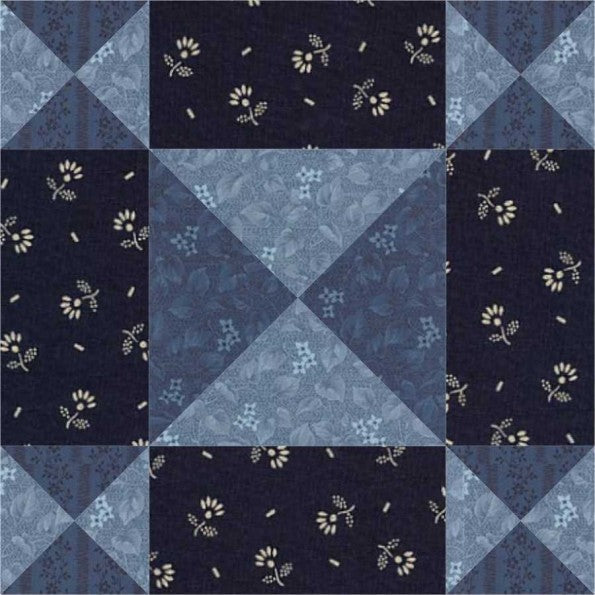
Design in Geometrics Quilt Block Pattern

To keep these classes free please leave a donation for the teacher here. https://customclothingboutique.com/products/donat-to-motley-muse

Click here for a beginner in depth sewing class on all the basics. https://customclothingboutique.com/pages/quilting-knowledge
On the back of the lighter fabric, draw a pencil line, diagonally from corner to corner.

Stack a pair of light and dark squares, right sides together. Sew a 1/4 inch seam allowance on each side of the line.

You will end up with something like this.

Now cut along the diagonal line.

Press the seam together to set the seam. Then press towards the darkest fabric.

To trim the block to the exact size line up the diagonal 45°angle with the ruler on your seam.

And then carefully trim your block with a rotary cutter.

On the back of the lightest square draw a pencil line 90° to the existing seam on the diagonal:

Butt the central seems:

Sew a 1/4 inch seam allowance on the right and left side of the diagonal line.

Then cut the seam on the pencil line.

The secret to the nine patch is all about ironing seams so that they butt when they are joined.
Cut 5 A squares and 4 B squares in the required size.
Chain piecing, join a B square to only 3 of the A squares, right sides together, with a 1/4 inch seam allowance. No need to press just yet.
The result will be:

Next, take the remaining A and B squares and, chain piecing, join them to these units, right sides together, with a one 1/4 inch seam allowance:

Your result will be:

To make this faster you can cut strips.
Cut A and B strips for the appropriate width, and join them into A/B/A and B/A/B units. Note you will need twice the length of B/A/B strips, as there are two of these units. Once your strips are joined, right sides together, with a 1/4 inch seam allowance. Press every seam towards the dark fabric.
Cut across your pre-joined strips to create the units needed for the nine patch:

You will achieve the same result as above, but this method is faster.

To make a standard 9 patch, the width of the unit cut from pre-joined strips is the same as the width of the original strips.
Press all the seams to the dark fabric so that all the seems butt up.
Join the B/A/B units to your A/B/A units with butted seams, right sides together, with a 1/4 inch seam allowance.
The direction of the final, central seam is optional. But guided by the placement of the block in the larger scheme, and wherever possible, iron to facilitate budding the seam joints.
Wider Application:
Just as the 4 patch, you can apply this methodology to all kinds of 9 patch blocks. As long as the patch has an underlying 3x3 grid, no matter how many pieces, the basic principle applies. It is repeated over and over, each 9 patch laying adjacent to the next 9 patch. As long as you keep pressing seams in pairs of opposite directions, piecing will be smooth sailing.
Try these out. Each block has an underlying 3x3 grid, and can be pieaced as a 9 patch.

Sometimes it is not obvious which direction is the dark with complicated blocks like those above. Just remember the basic ironing plan is:

How to Resize Quilt Blocks:
